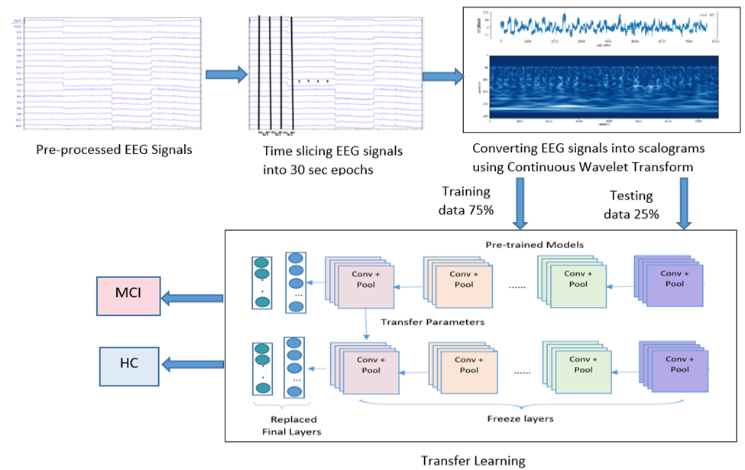Classification of Mild Cognitive Impairment with Deep Transfer Learning Approach using CWT based Scalogram Images
Main Article Content
Abstract
Mild Cognitive Impairment (MCI) is a condition that can occur as a person gets older, and faces problems like recognition, memory, and language skills. Early detection of MCI is crucial, as it can progress to more severe conditions like Alzheimer's disease. This study proposes a method to use Scalogram images, obtained by applying Continuous Wavelet Transform (CWT) to EEG signals and pre-trained models like ResNet50, VGG16, InceptionV3, Inception_ResNetV2 through transfer learning to classify MCI and Healthy Control (HC). Fine-tuning of the models is also used to improve the results, and various performance metrics are employed for classification. The study concludes that Inception_ResNetV2 transfer learning yielded good results, while ResNet50 and InceptionV3 transfer learning with fine-tuning resulted in higher accuracy using a low learning rate.
Article Details
References
Weller, J. and Budson, A., 2018. Current understanding of Alzheimer’s disease diagnosis and treatment. F1000Research, 7.
Prince, M.J., Wimo, A., Guerchet, M.M., Ali, G.C., Wu, Y.T. and Prina, M., 2015. World Alzheimer Report 2015-The Global Impact of Dementia: An analysis of prevalence, incidence, cost and trends.
Sabbagh, M.N., Lue, L.F., Fayard, D. and Shi, J., 2017. Increasing precision of clinical diagnosis of Alzheimer's disease using a combined algorithm incorporating clinical and novel biomarker data. Neurology and therapy, 6, pp.83-95.
Kim, D. and Kim, K., 2018, July. Detection of early stage Alzheimer’s disease using EEG relative power with deep neural network. In 2018 40th Annual International Conference of the IEEE Engineering in Medicine and Biology Society (EMBC) (pp. 352-355). IEEE.
Shikalgar, S. ., Yadav, R. K. ., & Mahalle, P. N. . (2023). An AI Federated System for Anomalies Detection in Videos using Convolution Neural Network Mechanism. International Journal of Intelligent Systems and Applications in Engineering, 11(1s), 218–227. Retrieved from https://ijisae.org/index.php/IJISAE/article/view/2496
Batum, K., Çinar, N., ?ahin, ?., Çakmak, M.A. and Kar?ida?, S., 2015. The connection between MCI and Alzheimer disease: neurocognitive clues. Turkish journal of medical sciences, 45(5), pp.1137-1140.
Aggarwal, S. and Chugh, N., 2019. Signal processing techniques for motor imagery brain computer interface: A review. Array, 1, p.100003.
Al-Fahoum, A.S. and Al-Fraihat, A.A., 2014. Methods of EEG signal features extraction using linear analysis in frequency and time-frequency domains. International Scholarly Research Notices, 2014
Carmen Rodriguez, Predictive Analytics for Disease Outbreak Prediction and Prevention , Machine Learning Applications Conference Proceedings, Vol 3 2023.
Boostani, R., Karimzadeh, F. and Nami, M., 2017. A comparative review on sleep stage classification methods in patients and healthy individuals. Computer methods and programs in biomedicine, 140, pp.77-91.
Zhang, Y., Liu, B., Ji, X. and Huang, D., 2017. Classification of EEG signals based on autoregressive model and wavelet packet decomposition. Neural Processing Letters, 45, pp.365-378.
Saeidi, M., Karwowski, W., Farahani, F.V., Fiok, K., Taiar, R., Hancock, P.A. and Al-Juaid, A., 2021. Neural decoding of EEG signals with machine learning: a systematic review. Brain Sciences, 11(11), p.1525.
Akin, M., 2002. Comparison of wavelet transform and FFT methods in the analysis of EEG signals. Journal of medical systems, 26, pp.241-247.
Zabidi, A., Mansor, W., Lee, Y.K. and Fadzal, C.C.W., 2012, September. Short-time Fourier Transform analysis of EEG signal generated during imagined writing. In 2012 International Conference on System Engineering and Technology (ICSET) (pp. 1-4). IEEE.
Omerhodzic, I., Avdakovic, S., Nuhanovic, A. and Dizdarevic, K., 2013. Energy distribution of EEG signals: EEG signal wavelet-neural network classifier. arXiv preprint arXiv:1307.7897.
Tagaris, A., Kollias, D., Stafylopatis, A., Tagaris, G. and Kollias, S., 2018. Machine learning for neurodegenerative disorder diagnosis—survey of practices and launch of benchmark dataset. International Journal on Artificial Intelligence Tools, 27(03), p.1850011.
Zhao, Y. and He, L., 2015. Deep learning in the EEG diagnosis of Alzheimer’s disease. In Computer Vision-ACCV 2014 Workshops: Singapore, Singapore, November 1-2, 2014, Revised Selected Papers, Part I 12 (pp. 340-353). Springer International Publishing.
Bi, X. and Wang, H., 2019. Early Alzheimer’s disease diagnosis based on EEG spectral images using deep learning. Neural Networks, 114, pp.119-135.
Fruehwirt, W., Cobb, A.D., Mairhofer, M., Weydemann, L., Garn, H., Schmidt, R., Benke, T., Dal-Bianco, P., Ransmayr, G., Waser, M. and Grossegger, D., 2018. Bayesian deep neural networks for low-cost neurophysiological markers of Alzheimer's disease severity. arXiv preprint arXiv:1812.04994.
Helaly, H.A., Badawy, M. and Haikal, A.Y., 2021. Deep learning approach for early detection of Alzheimer’s disease. Cognitive computation, pp.1-17.
Alvi, A.M., Siuly, S. and Wang, H., 2022. A long short-term memory based framework for early detection of mild cognitive impairment from EEG signals. IEEE Transactions on Emerging Topics in Computational Intelligence.
Bagherzadeh, S., Maghooli, K., Shalbaf, A. and Maghsoudi, A., 2022. Emotion recognition using effective connectivity and pre-trained convolutional neural networks in EEG signals. Cognitive Neurodynamics, 16(5), pp.1087-1106.
Olamat, A., Ozel, P. and Atasever, S., 2022. Deep learning methods for multi-channel EEG-based emotion recognition. International Journal of Neural Systems, 32(05), p.2250021.
Hadiyoso, S., Cynthia, C.L.F.A.R., ER, M.T.L. and Zakaria, H., 2019, September. Early detection of mild cognitive impairment using quantitative analysis of EEG signals. In 2019 2nd International Conference on Bioinformatics, Biotechnology and Biomedical Engineering (BioMIC)-Bioinformatics and Biomedical Engineering (Vol. 1, pp. 1-5). IEEE.
Almanza-Conejo, O., Almanza-Ojeda, D.L., Contreras-Hernandez, J.L. and Ibarra-Manzano, M.A., 2023. Emotion recognition in EEG signals using the continuous wavelet transform and CNNs. Neural Computing and Applications, 35(2), pp.1409-1422.
Joseph Miller, Peter Thomas, Maria Hernandez, Juan González, Carlos Rodríguez. Exploring Deep Learning Models for Decision Science Applications. Kuwait Journal of Machine Learning, 2(3). Retrieved from http://kuwaitjournals.com/index.php/kjml/article/view/198
Yang, D., Huang, R., Yoo, S.H., Shin, M.J., Yoon, J.A., Shin, Y.I. and Hong, K.S., 2020. Detection of mild cognitive impairment using convolutional neural network: temporal-feature maps of functional near-infrared spectroscopy. Frontiers in Aging Neuroscience, 12, p.141.
Narin, A., 2022. Detection of focal and non-focal epileptic seizure using continuous wavelet transform-based scalogram images and pre-trained deep neural networks. Irbm, 43(1), pp.22-31.
Sadiq, M.T., Aziz, M.Z., Almogren, A., Yousaf, A., Siuly, S. and Rehman, A.U., 2022. Exploiting pretrained CNN models for the development of an EEG-based robust BCI framework. Computers in Biology and Medicine, 143, p.105242.

